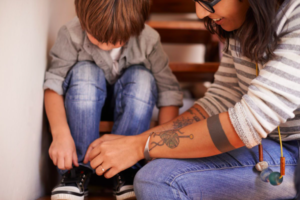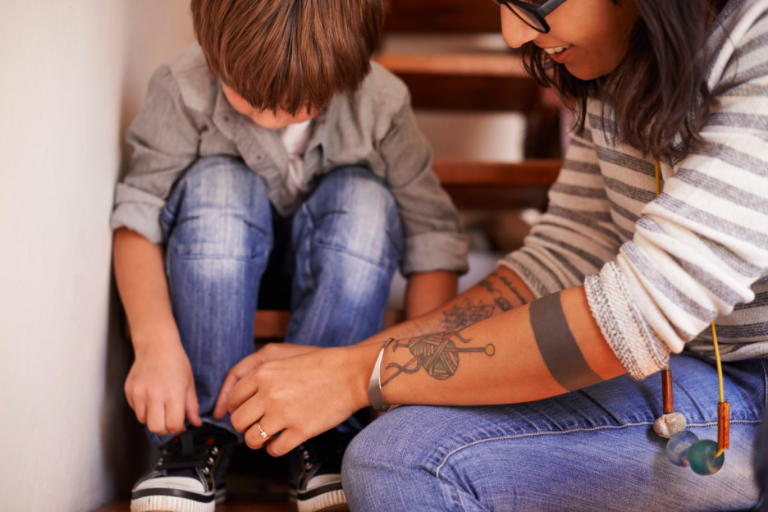1 | Practice tying shoes
If you send your child to school wearing shoes with laces, it is expected that at some point during the day they will need to be retied. Teaching your kid to tie shoes saves the teacher from doing it and will set a great example for other kids. That said, many five-year-olds haven’t developed the fine motor dexterity or the patience to master shoelaces, and fortunately for all involved, Velcro exists.
2 | Practice buttoning, zipping, and snapping
Your kindergartner will be expected to put on her own clothes for outdoor recess and to manage unfastening and refastening her pants to use the bathroom. While teachers and other adults are happy to help with gear – especially at the beginning of the year – it takes time away from other activities. In colder climates, snow pants, boots, hats, mittens, and winter coats add an extra 15 minutes to an already busy day of fun, so the faster kids are at this, the better.
3 | Bathroom independence is essential
Most schools require children to be capable of using the bathroom facilities in an age-appropriate way, meaning they Go, Flush, and Wash without assistance. While elementary schools are well-equipped to handle the inevitable accident with spare clothes on hand – and it’s certainly not the end of the world – it is inconvenient, embarrassing, and not much fun for the student.
4 | Know how to use scissors
Educators agree that cutting with safety scissors is an essential developmental skill and important on many levels, apart from its obvious use. Cutting with safety scissors allows a child to build up the tiny muscles in the hand by continuously opening and closing, it enhances hand-eye coordination, and it encourages bilateral coordination (using both hands while each one is doing something different). Kindergartners use scissors every day in lessons that incorporate both academic and hands-on learning.
5 | Memorize parents’ phone numbers
This seems like a no-brainer, but it doesn’t occur to every parent to drill a cellphone number into their child’s memory (I am that parent). Make it into a song, and they’ll learn it in a day. Addresses are helpful to know as well.
6 | Know how to hold a pencil
Ideally, your child should be writing his own first name, but if he can hold a crayon or pencil correctly, the rest will follow. Using other implements, such as silverware, paintbrushes, or styluses also develop the manual dexterity necessary for writing.
7 | Be able to navigate lunch
Your child should be adept at opening individual packages of food (Pinch, Pinch, Pull), other items (thermoses, juice boxes, water bottles), and be able to balance and carry a tray if they get hot lunch.
8 | Talk it up
Kids formulate their opinions by assessing their parents’ reactions. They study your words, body language, and disposition regarding anything big and new – like starting school – and they adopt the same attitude. If you act anxious, overly-sentimental, and reluctant about kindergarten, they will be apprehensive. If you speak positively about all the wonderful things they will do, act relaxed and enthusiastic, they will be inspired and confident.
9 | Hygiene awareness
Kids are walking germ factories by themselves, so imagine a classroom full of them. Make sure your child knows the School Sleeve Sneeze & Cough (in the crook of the elbow), washes her hands habitually after using the bathroom, and can blow her nose properly.
10 | Hug them every chance you get
A wise woman said, “The days are long, but the years are short, and summer is gone in a moment.” So when they say, “Mom, watch this!” really watch – you may never see it the same way again.
11 | Don’t cry till they’re out of sight
This I know: You will be emotional, you will miss them, and you will feel like they aren’t your babies any more, but the last thing they need is to wonder why you’re upset. Your child needs to feel good about growing up, and once you see them happy at school, you will, too.
Courtesy of Parent.co


